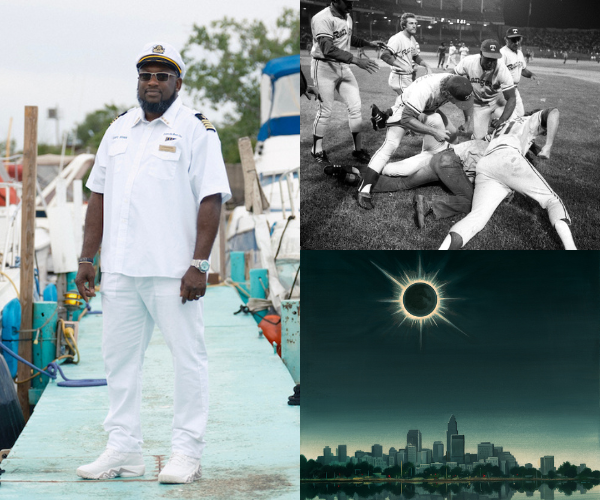What Happened to The City Club's Open Question Period?
by Sheehan Hannan | Oct. 9, 2017 | 12:00 PM

Kendra Huspaska
As I sit, Dan Moulthrop looks a little stricken by the mess on the table in his City Club of Cleveland office. “Do you mind if I clean?” he asks.
He shuffles papers, books and issues of Foreign Affairs onto side tables, his desk and into bookcase shelves. He’s winding down from a busy week. There is no forum this brisk Friday before Labor Day. But the previous one was the City Club’s mayoral primary debate, one of the bigger city political events of the year and a logistical feat for the club’s CEO.
Moulthrop and the club managed to get all nine candidates on the stage at the Global Center for Health Innovation for the primary’s only large-scale, televised debate. They fielded questions from 90.3 WCPN Ideastream’s Rick Jackson, before the traditional City Club question and answer.
The Q&A session is the most democratic aspect of Northeast Ohio’s forum of record. Anyone can ask a question, in the moment. Whenever I see a City Club staffer wield a microphone, I imagine it in the portly face of turn-of-the-century Mayor Tom L. Johnson.
Johnson fought his campaigns by setting up tent meetings and inviting all comers to debate and learn. His meetings were bare-knuckle political scrums, spattered in sweat and spit. A rich man who saw himself as a worker’s champion, Johnson would have loved asking questions at the City Club, had he lived to see its founding.
Today’s genteel questions from middle-aged attorneys are a far cry from Johnson’s rollicking gatherings. But it is remarkable that people stand up and ask sometimes-probing, sometimes-quixotic and sometimes-inane questions week after week, like they have for more than 100 years.
Some chime in from Facebook and Twitter now, which feels quaint and modern at the same time, like Kim Kardashian in a hoop skirt. But it’s still amazing, unprepossessing and thoroughly underappreciated. It’s very Cleveland. Which is Jackson’s next statement at the debate caught me off guard.
“Audience questions were submitted in advance and preselected by the City Club debate committee earlier this week. We will also take one question from social media,” Jackson said.
I didn’t notice the boilerplate at first. It sounded like something you would hear at a national debate. Sitting at a table up front, the audience members stood and read their questions. Written on notecards, they were dry but substantive.
Wait, what the heck happened to the open question period?
Back in his office, Moulthrop plops into a chair to explain, glasses pushed up on his forehead like a professor. He tells me the City Club has changed its approach, trying to uphold its mission to “create conversations of consequence and help democracy thrive.”
There isn’t much time during a televised debate. A bipartisan committee screens the questions to make sure they are fair and substantive, but only during debates, not the club’s usual forums.
I can see the necessity. The screeners might be needed in today’s hyper-partisan environment. They may make the debate better. But I hope they won’t be needed forever. If they are, I fear we will lose what sparks remain of the fire inside Johnson’s tent.
We should be debating as openly, vigorously and often as possible. The City Club embodies such a messy ideal. Rather than retreating to our own gerrymandered corners of political thought or curated civic discourse, we should be rushing to the center of the room microphone in hand. That’s how Cleveland and democracy improve.
In Johnson’s tent, supporters and haters alike got to ask, or shout, their questions. Johnson preached his message, fielded hecklers and, on occasion, debated his opponents. It wasn’t civil. But the tent meetings were a wonderful example of gruff, rough democracy. I ask Moulthrop: Isn’t there some value in preserving that sort of open-ended, unmediated forum?
“Absolutely,” he says. “That’s why we do what we do the rest of the year.”
But the unique demands of a debate, Moulthrop says, set the bar sky-high.
“Debates are really high-stakes moments for a lot of people,” Moulthrop tells me. “The quality of the questions is really important. We do [roughly] 120 programs a year, and 95 percent of them or more, anybody can get up and ask anything.”
The City Club Debate Committee began the debate overhaul in January 2016. The group of 35 bipartisan club members faced two problems: a perception of imbalance and trouble getting incumbents to show.
“It really came out of feedback that we were getting that our forum was not perceived as fair by all, as a fair place,” says Moulthrop. “I think Republicans in particular might say this — the Q&A was perceived as being a place where you could get sandbagged.”
The club was also having trouble getting some candidates in safe races to show up. In 2014, Ohio Auditor Dave Yost was the only statewide Republican officeholder to debate his opponent at the City Club.
“People act in their self-interest, and if they don’t perceive an appearance at the City Club to be in their self-interest, then that’s probably why [incumbents are reluctant to come to debates],” says Moulthrop.
The curated audience questions were a way to combat those concerns. By selecting measured questions, the City Club sought to change the perception that it was unfriendly to conservatives and, hopefully, woo more incumbents. The first test of the new format, during the 2016 Senate Democratic primary debate between P.G. Sittenfeld and Kelli Prather, mended some fences. Ted Strickland declined an invitation.
“Those who had criticized us in the past about sandbagging candidates with ‘gotcha’ questions were pleased with the process,” says Moulthrop.
Conservatives aren’t the only ones with qualms about debate at the City Club. Liberals cried foul when it invited President Donald Trump’s former campaign manager Corey Lewandowski for a forum.
I ask Moulthrop about the Lewandowski invite, and he springs over to his computer to pull up a picture.
It’s a shot from 1967, in black and white. Picketers wave signs outside the old City Club building on Short Vincent. Pro-segregation Alabama Gov. George Wallace was about to speak inside. The picketers on the street were mostly City Club members who thought Wallace didn’t deserve an invitation, says Moulthrop.
“When the program was about to begin, these guys all put down their signs and walked in and sat down and participated in the program,” he says.
“We have to challenge ourselves to include the voices that are difficult to hear, that for whatever reason, we may find difficult to hear,” Moulthrop continues.
Debate works. That’s why, even if the curation stays, the club’s open forum should be safeguarded and expanded.
Indeed, Moulthrop says, he’d like to see more debates about issues beyond the election season, such as the merits of the deal to renovate Quicken Loans Arena.
Johnson’s tent debates were far from perfect. The sweaty debaters were doubtless overly male and white. But that musty, dusty tent was a space for confronting our demons and pitching our best selves, a style of community introspection that flamed uniquely in Cleveland. It would be a shame to let that legacy quietly smolder to ash.
Trending
-
1
-
2
-
3
-
4
-
5










